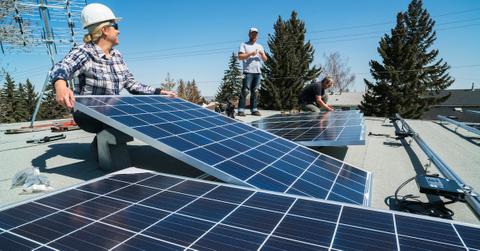Renewable Energy Will Exceed Coal-Powered Energy This Month in U.S. for the First Time
This is a milestone for the U.S.
Updated April 30 2019, 2:46 p.m. ET

Renewable energy has been on the rise in the U.S. for years — but this month, it's reaching new heights. As the Institute for Energy Economics & Financial Analysis (IEEFA) reported, the month of April 2019 is slated to be the first in U.S. history where renewable energy generates more electricity than coal-powered plants.
The IEEFA shared the news based on the U.S. Energy Information Administration's (EIA) report Short-Term Energy Outlook, which published the projected data on April 9. As the IEEFA explained, the renewable energy sector, which includes hydro, biomass, wind, solar, and geothermal energy, is expected to produce more electricity nationwide than coal in both April and in May of this year.
If you're into numbers, the IEEFA estimates that in April, renewables will generate 2,322 thousand megawatt-hours per day, while coal will generate 1,997 thousand MWh/day. In May, the IEEFA estimates that renewables will generate 2,271 thousand MWh/day, and coal will generate 2,239 thousand MWh/day.
So, what accounts for this sudden shift? According to the IEEFA, it likely has to do with the season. As the institute explained, coal plants traditionally get maintenance and upgrades during the spring and fall, because Americans typically use the most power in the summer and winter. Plus, as the IEEFA noted, spring is an ideal time to capture hydro-generated power. So while April renewables are set to bring more May renewables, June could shift back to a greater reliance on coal.
Additionally, as CNN noted, recent investments into wind and solar energy have helped decrease the cost of renewable energy, meaning people who previously could not afford it now can. Not to mention, the current climate crisis has led to businesses, governments, and private citizens demanding cleaner energy sources — and when there is greater demand, there is greater supply.
"Five years ago this never would have been close to happening," Dennis Wamstead, an IEEFA research analyst, told CNN. "The transition that's going on in the electric sector in the United States has been phenomenal ... Renewables are just a better bet at the moment."
Another reason for this shift nationwide is thanks to cities pledging to shift towards clean energy. For example, earlier this year, Los Angeles Mayor Eric Garcetti announced plans to replace three of L.A.'s gas-powered power plants with clean energy sources. And this week, L.A. announced another goal as part of the city's Green New Deal: to run on 100 percent renewable energy sources by 2045. Similarly, Chicago recently pledged to run the city (and its entire bus fleet) on 100 percent renewable energy by the year 2040. L.A. and Chicago are not the only cities with these pledges — the Sierra Club formed a Ready for 100 club, made up of the cities, counties, and states who have pledged 100 percent renewable energy by 2050 or earlier.
Interestingly, renewable energy will only produce 18 percent of U.S. electricity in 2019, and around 20 percent in 2020, according to the IEEFA. While those figures are increasing slowly but surely, renewable energy still has a long way to go before it provides the majority of the country's energy.